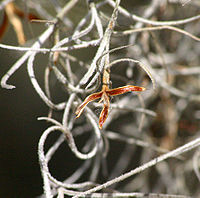Spanish Moss




Months in season
| Jan | Feb | Mar | Apr | May | Jun |
| Jul | Aug | Sep | Oct | Nov | Dec |
Summary
Spanish moss (Tillandsia usneoides) is an epiphytic flowering plant that often grows upon larger trees in tropical and subtropical climates, native to much of Mexico, Bermuda, the Bahamas, Central America, South America, the southern United States, French Polynesia and the West Indies and is also...
summary via wikipedia
Spanish Moss data for nerds
Below is a live look at how Spanish Moss flowers are used in floral estimates by Lobiloo users.
Spanish Moss's popularity last 12 months
Utility of this flower in recent floral estimates
Loading...
Spanish Moss's inclusion by total price of event
*Detect if this flower is better suited for lower vs higher budget productions
Loading...
Spanish Moss wholesale pricing and regionality
Learn whether the Spanish Moss is popular in , and if you're paying the right amount.
Spanish Moss's popularity by state
*Last 90 Days
Loading...
Spanish Moss's recent wholesale prices
*Bell curve, represents average price per stem for a given % of florists
Loading...
